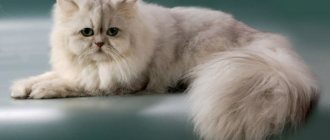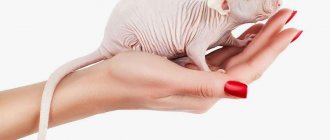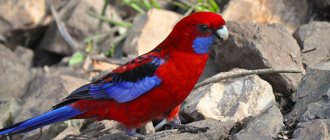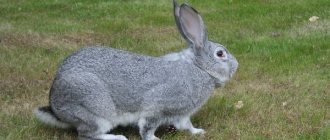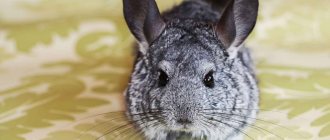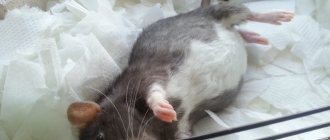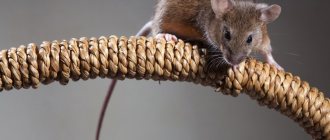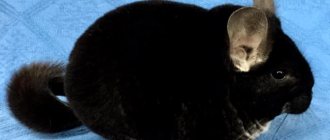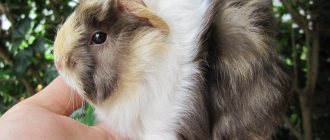Chinchilla temperature
In order for your pet to feel comfortable in its new living conditions, it is necessary to create a favorable climate for chinchillas.
The room where animals live must have a sufficient amount of oxygen, a constant temperature and a stable level of air humidity. If there is excess moisture or heat, especially in winter or in hot weather, the room is ventilated, while making sure that there is no draft. What is the temperature for keeping chinchillas?
The temperature regime for chinchillas is regulated by turning on or off the air conditioning, central heating or heater. A favorable climate for chinchillas does not depend on where they are kept. The temperature for chinchillas should fall no lower than +10 degrees, rise no higher than +23 degrees, but the relative humidity should not be more than 60%. If the microclimate parameters exceed the specified values, chinchillas immediately begin to feel unsatisfactory.
The temperature at which chinchillas are kept significantly affects their appearance and the quality of their fur. Such changes are observed not only in natural habitats, but also when kept in a cage. For example, if the ambient temperature is below +12 degrees, the animals grow larger, their coat becomes thicker, and the pile is longer. If the temperature is too high for a chinchilla, then the animals become smaller, the fur becomes less dense and thick, and the pile grows shorter.
Scientists have found that for a chinchilla, a temperature of +1-2 degrees will not be uncomfortable if a well-insulated chinchilla house is installed in its cages.
Comfortable microclimate for chinchillas. How to create it?
High temperatures in summer force chinchillas kept in a garden enclosure to hide from the heat in stone embankments, and in rainy weather in wooden houses. Instead of stones, you can put a part of a cement pipe up to 160 centimeters long in the enclosure, which needs to be covered with earth. In such a shelter, animals feel comfortable both in the heat and during the rains.
You can make an artificial hole for chinchillas as a refuge. To do this, you will need to dig a wooden house with an area of 40x30 centimeters and a height of 20 centimeters into the ground and connect it to the surface of the earth with three passages (the length of each passage is 1.5 meters), lined with brick. From above, the entire structure is covered with a layer of earth. In such burrows, animals can successfully hide from bad weather or feed their offspring.
Remember! Excessively high or low for chinchillas lead to the death of animals, especially young animals.
You can learn more about what temperature regime is most preferable for chinchillas at home on other pages of our resource.
Reproduction
Chinchillas are low-bearing animals; the litter averages 1-2 cubs per litter. The birth rate increases as the rodent gets older; the older the female, the higher the likelihood of a large litter. The average number of births from one female is 3-4 cubs per year.
Small chinchillas in the same litter differ in size and activity. As a rule, the smallest children do not get their mother's milk, so a large family requires close attention, and weak babies need artificial feeding.
Large chinchilla farms practice polygamous breeding, when one male is used to mate with several females at once, whose sexual maturity is reached at the age of 6 to 8 months.
The average duration of pregnancy in rodents is 105 -117 days; the interesting position of the female can be determined only in the second period of gestation, when the expectant mother is rapidly gaining weight.
The average weight of newborn babies is 30-75 grams; if the baby is full-term, then it is born covered with fur, sighted and with teething. The average duration of milk feeding is up to 2 months of age, but you can introduce food into the diet of a small chinchilla starting from a week of age.
The most dangerous period in the life of newborn pets is the first 2 weeks. At this moment, even a significant temperature deviation can be critical. It is customary to separate babies from their mother at the age of two months, when their weight reaches 240-250 grams.
Black chinchilla
Conditions for keeping chinchillas
If you decide not only to own such a rare animal as a chinchilla, but to seriously engage in breeding it, then you should know something about the conditions in which chinchillas should be kept.
Their natural habitat is a fairly arid area, where air humidity rarely exceeds thirty percent. Of course, at home it would be very difficult to achieve such a result, so for breeding these animals, foreign and domestic chinchilla farms adhere to numbers ranging from 50 to 70 percent air humidity.
If the humidity in the room exceeds 70 percent, then there is a huge chance that your pets will be very sick and have poor quality fur. Also, you should not store pet food in damp areas. In a month of such storage, without noticing it, you will grow a fungus on it. And once again, having fed your chinchillas with this food, you have a great chance of finding them in the cage in the morning, lying with their paws up.
The temperature of keeping animals should not exceed thirty degrees, as it is fatal for them. The most optimal temperature for keeping Chinchillas is from 15 to 18 degrees, the mark of 25 degrees is the limit, but still acceptable. There are also cases where chinchillas were kept at sub-zero temperatures, but it’s better not to take risks.
First meeting
Chinchillas are naturally very timid animals - they flinch at any sudden movement or unexpected sound. It is not surprising that upon arrival at a new place of residence, where everything is new for the pet, the fluffy will be extremely careful. Therefore, you should not force your attention on the animal. You need to give the chinchilla 10-12 days to adapt - let it get used to all family members, their voice, and daily routine.
All this time you should not touch, much less pick up, the chinchilla. After all, moving in itself is already a huge stress for the animal. Therefore, excessive interest on the part of household members will only delay the process of the pet getting used to the new place.
External conditions for keeping a chinchilla
The chinchilla has very significant advantages over other rodents - beautiful thick fur and the absence of a specific smell. But it is precisely these advantages that dictate certain conditions for keeping the animal at home.
Why doesn't a chinchilla smell? - Because she has no sweat glands.
How can she handle the heat in such a chic fur coat? - Very hard.
This means that the optimal temperature for keeping this exotic animal in an apartment is the range from 16 to 21 degrees Celsius. It can be a little lower, it can be a little higher, literally 2-3 degrees.
It should be remembered that cold in such a fur coat is much more preferable than heat. We know of cases where chinchillas are kept at a minimum temperature of 5 degrees (it is important that it is positive) in a closed room without drafts.
The maximum permissible upper threshold value is 25 degrees.
If the temperature in your home exceeds this limit in the summer, you risk the life of your pet, since it is not always possible to recognize heatstroke in time and take action, and therefore in the warm months of the year the mortality rate of chinchillas due to overheating increases.
You can avoid sudden temperature fluctuations by installing an air conditioner in your home, which can maintain a stable temperature in the house all year round. And a stable cool temperature will give your pet the opportunity to grow a thick, beautiful, shiny coat that will become the subject of your pride and admiration.
Using a fan in hot weather to cool a chinchilla is ineffective, since the fan circulates the same hot air around the room and, using direct blowing, makes life somewhat easier for humans and animals that can sweat through their skin.
In a chinchilla, a draft causes colds and pneumonia, which develop rapidly, are difficult to treat and often end sadly, so never turn the air conditioner or fan towards the cage. Also, the cage should be in a place where there is no draft from an open window or door.
Accordingly, direct sunlight on the cell is extremely undesirable, as it can cause overheating.
However, the lack of direct sun in the cage does not mean that the chinchilla should be locked in a cold closet without windows. The chinchilla needs sunlight, like any other living creature, it participates in the processes of development, regeneration, and reproduction.
Another condition for keeping a chinchilla is air humidity. Chinchillas in nature live in very dry conditions; sometimes it rains in the mountains of Chile for only a few days a year. The fur of the animal is very hygroscopic and easily absorbs moisture from the air, so the recommended humidity level in a room with a chinchilla is 60%. The danger of humidity is that the more invisible water accumulates on surfaces, the more fertile soil is created for the development of fungal diseases, one of which is lichen.
Humidity and temperature
A chinchilla should be given a bright, dry room in which the most favorable conditions for the animals are created. In the chinchilla barn, where the animals live until they find new owners, a fairly stable temperature is maintained all year round (14 - 18'C). It was found that at temperatures below 10′ and above 25′C, chinchillas begin to feel unsatisfactory.
An equally important factor for the well-being of chinchillas is air humidity. The relative air humidity should not be allowed to exceed 75%. The most optimal is 50 - 60%.
Sources: xn--80apaieal0gc.xn--p1ai, shinshilarus.ru, chinclub.ru, angorahouse.ru, www.apus.ru
Rabbit lop-eared ram
Rabbits of the Dwarf Fold Ram breed were bred around 1950 in Holland. This breed is quite young and was obtained as a result.
How to play with your pet
Pet chinchillas are afraid of sharp sounds, so you need to move as quietly as possible in their presence. At first, the animal needs to get used to the new environment and smells. You should pick it up gradually so as not to scare it. You cannot force an animal out of its cage. When the pet gets used to it and begins to trust its owner, you can start playing with it. To do this, it is recommended to use various toys:
- Products made from natural materials. Wooden toys allow the animal to sharpen its claws and teeth. Instead of store-bought ones, you can use simple branches from hardwood trees.
- Labyrinths and tunnels are in great demand among rodent owners. You can make them yourself using plastic or wood.
- For animals that are very active, a running wheel is suitable. A chinchilla can spend several hours in it. Stairs can also be used as a running machine. They are installed in the display case in the openings of the shelves. Often the pet scratches its back on them.
Conditions close to “wild”
The chinchilla's natural habitat is the desert highlands of South America (Chile, Bolivia, Argentina). The air temperature here remains at 12-18 degrees Celsius. The thermometer in nature can drop lower, and then animals use fluffy fur to keep warm. In rodents living in cold conditions, it is thicker and more lush.
Chinchillas live in the dry, cool conditions of the highlands of South America.
Maintaining the temperature in an apartment below 16 degrees is problematic, and it is not necessary. The optimal figure is 16-18 degrees with a plus sign. But chinchillas also tolerate warmer “weather” well - up to +23 C. But it shouldn’t be hotter in the place where the furry animal lives - otherwise the pet will experience overheating, which will affect its well-being, health and appearance.
Rodents can withstand cold weather much better. There are cases where chinchillas are kept at temperatures close to natural. At the same time, the air temperature can drop to +6 degrees. The main thing is that the animal has a warm house in which it can hide from the cold (analogous to a natural burrow).
It is important that the temperature in the room where the furry is located does not change sharply. To maintain a stable environment, air conditioning and heating devices should be used. Only animals should not experience drafts or excessive heat (for example, from a radiator).
It is better to place the cage away from drafts and heating devices
In winter, during the heating season, it is better to place the cage with the chinchilla away from the window where the radiator is usually located. This will also protect you from drafts from the window. Also make sure that the air flow from the air conditioner (or fan) is not directed towards the animal’s house. A draft does not cool the body of an animal that cannot sweat - but, on the contrary, causes colds and even pneumonia (a disease fatal to chinchillas).
In summer, the animal must be protected from direct sunlight. If your pet stays in the sun for a long time, it will inevitably overheat and get sick. But you cannot completely protect your pet from the light, which he needs like any living creature.
Let's sum it up
Chinchilla does not like either heat or frost. But it can withstand cold better than heat. Comfortable temperature for the animal is 16-18 degrees. During heating periods, keep the cage away from the radiator, and in summer limit exposure to direct sunlight.
Sudden changes in temperature are especially dangerous for a rodent, since its body is not able to regulate heat as well as a human.
Chinchillas do not sweat, so blowing cold air does not play any role for them. But the risk of getting a cold or pneumonia increases. The cage is placed away from windows, air conditioning and fans.
Cold air is most dangerous for a rodent with a wet coat. After bathing, it should be dried thoroughly with a hairdryer and towel. Your pet's fur needs to be kept dry so it will be nice and thick.
The optimal humidity in the room is no more than 60%. When the humidity level rises, it is necessary to ventilate the room. In addition, make sure there is sufficient lighting and fresh air required for the development of the animal.
The drier the better
In the wild, where exotic rodents live, dry conditions are maintained. In the desert highlands, air humidity reaches 30%, and for chinchillas this is the most favorable indicator. It is unrealistic to achieve this level of humidity in an apartment. But we need to ensure that it does not exceed 50-60%.
The house is dry - the chinchilla is happy
When humidity exceeds 70%, the room must be ventilated. If the animal is constantly in a humid environment, it will inevitably begin to get sick, its health will worsen, and its appearance will lose its former shine. A clear symptom of excess humidity is a decrease in the quality of the animal’s fur.
Hygroscopic fur, designed for high mountain dryness, easily absorbs moisture and does not release it well. That is why, in conditions of high humidity, fungal infections and lichens may appear in the fur coat, which are difficult to treat.
Chinchillas do not have sweat glands, so they do not emit a specific odor. This “aesthetic” advantage sometimes turns into disaster for animals. Their body is not capable of self-regulation under conditions of sudden changes in heat and humidity. This is why it is not recommended to bathe fluffies in water (only in rare cases and then thoroughly dry them). Thick fur, when wet, causes hypothermia, which is fatal to rodents.
High humidity can be a big problem
High humidity also affects your pets' food. If you don’t monitor its quality, you may miss the moment when it becomes covered with fungus. And this is fraught with food poisoning of the animal - even death.
Is it possible to walk in cold weather?
Some chinchilla breeders practice outdoor activities. Indeed, in the wild, animals successfully cope with the challenges of the external environment. But in urban conditions, not everything is so simple. For example, a curious animal may find something “interesting” in the ground and get poisoned. In addition, for a pet living indoors, going outside is a huge stress. Is it necessary to subject it to such tests?
If, in spite of everything, you decide to walk the animal (even if only on the balcony), remember the conditions recommended for it. The environment should be comfortable and stable. You should refrain from “partying” at temperatures below 5-6 C, and even more so if the air is saturated with moisture or it is raining outside.
Domestic chinchilla experiences stress during a walk
On a hot sunny day, walking is also contraindicated, since overheating is possible. During the warm summer months, chinchillas are generally less active. They move less, eat more modestly, and bear offspring less often (the mating season starts in the fall).
Crossbreeding
Chinchilla breeds were developed by crossing. If animals of the same color participate in it, all offspring will be the same. If the color of the parents is different, interesting colors may appear. They may not even be like mom or dad, but more distant ancestors.
When crossing domestic chinchillas, you can achieve a variety of shades because recessive genes can manifest themselves.
It is very important to know what genes the animals have, because it is impossible to allow the combination of two lethal ones - black and white. In this combination, the babies born do not survive, and the carrying female may also die.
It is not desirable for both parents to have the velvet gene because it reduces the number of offspring.
Usually, chinchillas are not crossed if one of them does not have the ebony gene and the other does, because the result may be offspring that have a disturbed color.
It is prohibited to crossbreed animals with family ties.
